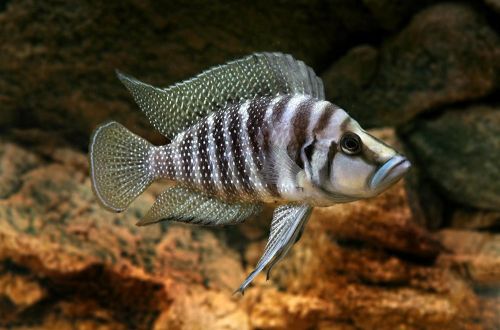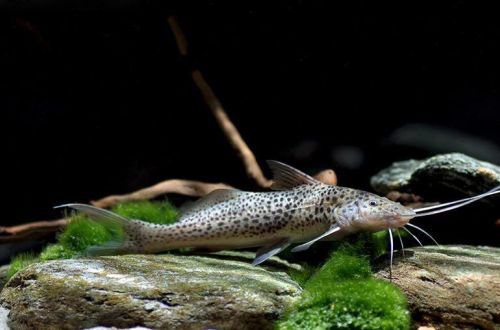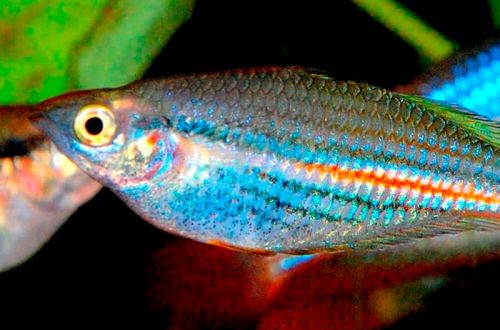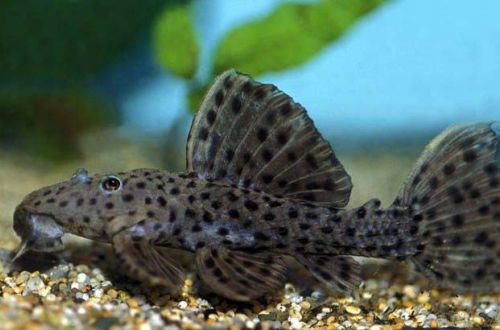
cichlid calvus
The Calvus cichlid, scientific name Altolamprologus calvus, belongs to the Cichlidae family. Calm and relatively peaceful fish, although it belongs to predators. Attacks only those fish that can fit in her mouth. Can be used in community aquariums. It is easy to keep and breed, but the need to maintain stable water conditions does not allow it to be recommended to beginner aquarists.

Contents
Habitat
Endemic to Lake Tanganyika in Africa, located mainly between Tanzania and the Democratic Republic of the Congo. Lives exclusively along the rocky coastline.
Brief information:
- The volume of the aquarium – from 150 liters.
- Temperature – 24-27°C
- Value pH — 7.5–9.0
- Water hardness – medium hardness (8-21 dGH)
- Substrate type – sandy / rocky
- Lighting – moderate
- Brackish water – no
- Water movement – weak, moderate
- The size of the fish is 12–14 cm.
- Nutrition – meat feed
- Temperament – conditionally peaceful
- Keeping in a pair or in a harem with one male and several females
Description
Adult individuals reach a length of up to 14 cm. Sexual dimorphism is weakly expressed, males are only slightly larger than females. Color varies from gray to dark. The body pattern consists of dark vertical stripes. A characteristic feature of the species is a laterally compressed body and an elongated head. This structure allows fish to hunt among the rocks, squeezing into narrow crevices.
Food
Predator, refers to carnivorous species. In a home aquarium, it can accept fresh or frozen meat products. For example, the meat of fish, shrimp, mussels or other invertebrates, including large bloodworms, brine shrimp.
Maintenance and care, arrangement of the aquarium
Optimal conditions are achieved in a biotope aquarium that mimics the natural habitat of Lake Tanganyika. Tank sizes for several Calvus cichlids start at 150 liters. In the design, heaps of stones and fragments of rocks are used, from which crevices and grottoes are formed. It is noted that dark substrates stimulate the coloration of fish, while light ones, on the contrary, make it dull.
Keeping stable water conditions with suitable hydrochemical values is key. Installation of a productive filtration system along with a weekly replacement of part of the water with fresh water are mandatory. Regular cleaning of the aquarium is also important.
Behavior and Compatibility
It belongs to the territorial and predatory, but at the same time relatively peaceful species. Perfectly compatible with the calm views from Lake Tanganyika. Mbuna cichlids and other aggressive fish, as well as those that can fit in the Calvus mouth, should be avoided. It is acceptable to keep in a pair or a small group.
Breeding / breeding
Calvus cichlids form a pair for the breeding season, but on the condition that they grew up together. If you plant two or more adult fish grown in different places, then you can forget about breeding.
Fish are able to breed in a common home aquarium, but it is unlikely that they will be able to raise offspring. It is highly likely that it will become a victim of other fish and males. Favorable conditions are achieved in a separate spawning tank. With the onset of the mating season, the male chooses a crevice or grotto and invites the female to her. The eggs are fixed inside the cave, the male is located outside and releases the seed. Then it swells with fins towards the eggs – this is how fertilization occurs. In turn, the couple guards the masonry. After 8–10 days, fry appear, after another couple of days they begin to swim freely. From this point on, it is advisable to remove the male so that he does not eat his own offspring. Females usually do not touch them.
Feed Artemia nauplii, small bloodworms.
The fry grow unevenly. Smaller fish need to be repotted as they mature or else they may be eaten.
Fish diseases
The main cause of most diseases of cichlids from Lake Tanganyika is unsuitable housing conditions and poor quality food, which often leads to such a disease as African bloat. If the first symptoms are detected, you should check the water parameters and the presence of high concentrations of hazardous substances (ammonia, nitrites, nitrates, etc.), if necessary, bring all indicators back to normal and only then proceed with treatment. Read more about symptoms and treatments in the Aquarium Fish Diseases section.





